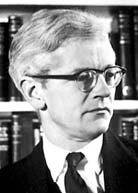
Sir John Cowdery Kendrew, CBE, FRS (24 March 1917 – 23 August 1997) was an English biochemist and crystallographer who shared the 1962 Nobel Prize in Chemistry with Max Perutz; their group in the Cavendish Laboratory investigated the structure of heme-containing proteins.
Kendrew attended Trinity College, Cambridge in 1936, as a Major Scholar, graduating in chemistry in 1939. He spent the early months of World War II doing research on reaction kinetics, and then became a member of the Air Ministry Research Establishment, working on radar. During the war years, he became increasingly interested in biochemical problems, and decided to work on the structure of proteins.
Kendrew shared the 1962 Nobel Prize for chemistry with Max Perutz for determining the first atomic structures of proteins using X-ray crystallography. Their work was done at what is now the MRC Laboratory of Molecular Biology in Cambridge. Kendrew determined the structure of the protein myoglobin, which stores oxygen in muscle cells.
In 1963 Kendrew became one of the founders of the European Molecular Biology Organization; as well, he founded and was for many years editor-in-chief of the Journal of Molecular Biology. He became Fellow of the American Society of Biological Chemists in 1967 and honorary member of the International Academy of Science. In 1974 he succeeded in persuading governments to establish the European Molecular Biology Laboratory in Heidelberg and became its first director. From 1974 to 1979 he was a Trustee of the British Museum, and from 1974 to 1988 he was successively Secretary General, Vice-President, and President of the International Council of Scientific Unions.
After his retirement from the European Molecular Biology Laboratory, Kendrew became President of St. John's College at Oxford University, a post he held from 1981-1987. From 1974-79 he was a Trustee of the British Museum and from 1974 to 1988 he was successively Secretary General, Vice-President and President of the International Council of Scientific Unions.